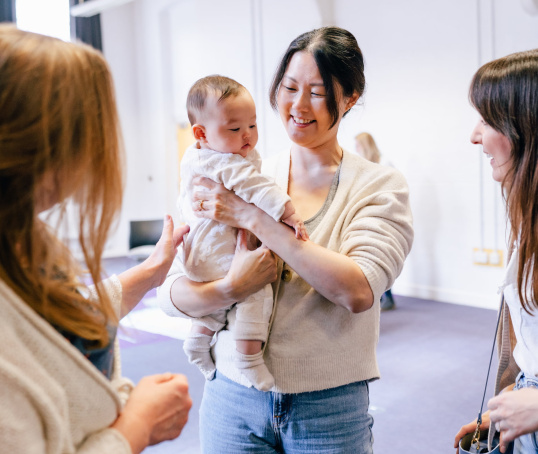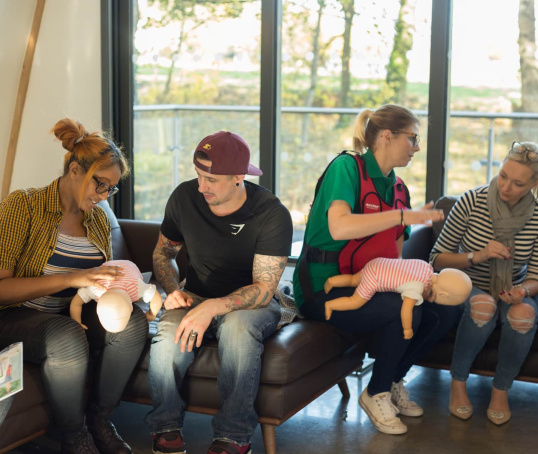Find out what happens when you give birth at home, and whether it could be for you. Here’s your guide to a different sort of birth experience.
Home births mean home comforts
For many women, the cuddle with your new baby on your own sofa, or snuggle with them in your own bed afterwards makes a home birth very appealing.
Giving birth at home is not as common today but things are changing
Only 2.1% of births in England and Wales happened at home in 2016 (ONS, 2016). Most of the women who did give birth at home were 35 to 39 years old (ONS, 2016).
One in five women would like information on giving birth at home, and the support to do it (Singh and Newburn, 2000). It’s also believed that if women felt like it was totally their choice, around 10% would bring their babies into the world at home (RCOG and RCM, 2007). So if you want a home birth, definitely consider it as an option.
Home births can be more straightforward than hospital births
A huge bonus of a planned home birth is that it’s likely to be more straightforward than one that happens in hospital (Li et al, 2015; Rowe et al, 2016). That means lots of benefits for you, your baby and your birth partner.
Home births don’t always happen deliberately
Most home births are arranged over months of planning with a midwife. Yet a small proportion of unplanned home births just happen because your baby comes along a little faster than expected.
Home births don't necessarily mean more risk
If you have a straightforward pregnancy and the baby is looking healthy, a home birth can be a strong option (Brocklehurst et al, 2011; De Jonge et al, 2014). It might be different if things are complicated though, so speak to your midwife. You can both go through your individual situation and work out what's best for you and your baby (NICE, 2014).
There is a difference in outcomes depending on whether this is your first baby or not. For women having a second baby, there is actually no difference in the safety of either mum or baby by planning to give birth at home compared to in a hospital or midwife led unit (Brocklehurst et al, 2011).
For first-time uncomplicated pregnancies, there is a difference in terms of risk of problems for the baby. The ‘adverse outcomes’ for baby increased from 4 in 1,000 to 9 in 1,000 for first births (Brocklehurst et al, 2011).
Not all pain relief options will be available
If you have your baby at home, you won’t be able to have an epidural but you can still have gas and air, pethidine/diamorphine or a TENS machine (NHS Choices, 2017). If you live in Scotland, check with your NHS board which pain relief options are available to you as pethidine and diamorphine may not be offered at home births. You could also try relaxation or hypnobirthing techniques you’ve learned during pregnancy. Or you could ease the pain in a birthing pool or – a bonus of being at home – hop into a bath.
Do note though that most alternative pain relief techniques are not proven pain relievers (NHS Choices, 2017). Check out our page on pain relief options at a home birth for more detailed information.
You can always change your mind about a home birth
Whatever decision you’ve made about where you want to have your baby, you can change your mind at any point in your pregnancy. And even when you’re in labour. Your midwife can arrange for you to be transferred to hospital in an ambulance if needed, so you get there quickly for whatever you need or want.
You never know what will happen on the day so it might be a good idea to pack a hospital bag just in case. Keep the things you need for the birth in a separate box that you can use at home, then it’ll be easy to sling that into the bag too if you need to be transferred to hospital.
Reasons for choosing a home birth vary
You might choose a home birth because you’re anxious about hospitals (maybe due to something you’ve been through before). You might also choose it because it keeps a bit more normality for older children. Whatever your reason, it’s totally valid.
You’ll have a midwife with you
A community midwife – or independent midwife if that’s what you’ve arranged – will pop out to you when you’re in labour (NICE, 2014). They might stay or if you’re not too far along, they may leave and come back later. See our ‘who will care for you during a home birth’ page for more info.
You won’t need much equipment
See our page on the equipment you’ll need to get a full picture. Most things (like towels) will be things you’ll already have in your house. If you're worried about after-birth mess, you can talk through what you might need or expect with your midwife beforehand too.
In some areas, your midwife will bring a birth pack round a few weeks before you have your baby too, with everything crucial in it. Midwives will have the same equipment at a home birth as they would have on a midwife-led unit (MLU). This includes the drugs used to prevent excessive bleeding and resuscitation equipment.
Your midwife can provide your aftercare in a home birth too
If you need stitches for a tear or episiotomy after you’ve had your baby, your midwife will probably be able to do those in your home. If you have a really bad tear though – or any other complications – you’ll be transferred to hospital (Brocklehurst et al, 2011).
This page was last reviewed in October 2018.
Further information
Our support line offers practical and emotional support with feeding your baby and general enquiries for parents, members and volunteers: 0300 330 0700.
We also offer antenatal courses which are a great way to find out more about birth, labour and life with a new baby.
Make friends with other parents-to-be and new parents in your local area for support and friendship by seeing what NCT activities are happening nearby.
The Home Birth Reference Site provides information and opinions about having your baby at home, for parents who think that it might be the right choice for them, and for health professionals looking for resources.
Which? and Birth ChoiceUK have developed a tool to help you find out what your choices are for giving birth in your area. This tool combines your preferences with research evidence to show the local options most suited to you.
AIMS. (2016) Booking a home birth. Available from: https://www.aims.org.uk/information/item/booking-a-home-birth [last accessed 5th October 2018].
Brocklehurst P, Hardy P, Hollowell J, Linsell L, Macfarlane A, McCourt C, Marlow N, Miller A, Newburn M, Petrou S, Puddicombe D, Redshaw M, Rowe R, Sandall J, Silverton L, Stewart M. (2011) Perinatal and maternal outcomes by planned place of birth for healthy women with low risk pregnancies: the Birthplace in England national prospective cohort study. BMJ. (343):d7400. Available from: https://doi.org/10.1136/bmj.d7400 [last accessed 9th October 2018].
Bryan N. (2018) Freebirth data ‘should be collected across UK. Available from: https://www.bbc.co.uk/news/uk-wales-south-east-wales-42706652 [last accessed 9th October 2018].
De Jonge A, Verhoeven C, Thornton J (2014) Perinatal mortality and morbidity up to 28 days after birth among 743 070 low‐risk planned home and hospital births: a cohort study based on three merged national perinatal databases. BJOG. 122(5):720-728. Available from: https://doi.org/10.1111/1471-0528.13084 [last accessed 9th October 2018].
NICE. (2014) CG190 Intrapartum care for healthy women and babies. Available from: https://www.nice.org.uk/guidance/cg190/ [last accessed 5th October 2018].
ONS. (2016) Birth characteristics in England and Wales. Available from: https://www.ons.gov.uk/peoplepopulationandcommunity/birthsdeathsandmarriages/livebirths/bulletins/birthcharacteristicsinenglandandwales/2016, [last accessed 9th October 2018].
RCM. (2008) Position paper 25 Home birth.
RCOG/RCM. (2007) Joint statement No. 2, Home births.
Rowe R, Li Y, Knight M, Brocklehurst P, Hollowell J. (2016) Maternal and perinatal outcomes in women planning vaginal birth after caesarean (VBAC) at home in England: secondary analysis of the Birthplace national prospective cohort study. BJOG. 123(7):1123-1132. Available from: doi: 10.1111/1471-0528.13546. [last accessed 9th October 2018].
Singh D, Newburn M. (2000) Access to maternity information and support: the needs and experiences of pregnant women and new mothers. London: NCT. [last accessed 9th October 2018].
Further reading
Bryan N. (2018) Freebirth data should be collected across UK. Available from: https://www.bbc.co.uk/news/uk-wales-south-east-wales-42706652 [last accessed 10th October 2018].
Feeley C, Thomson G. (2016) Why do some women choose to freebirth in the UK? An interpretative phenomenological study, BMC Pregnancy Childbirth 16:59. Available from: DOI: 10.1186/s12884-016-0847-6 [last accessed 9th October 2018].
Horn A. (2010) Fathers and homebirth. Home Birth Reference Site. Available from: http://www.homebirth.org.uk/blokes.htm [last accessed 9th October 2018].
Li Y, Townend J, Rowe R, Knight M, Brocklehurst P, Hollowell J. (2014) The effect of maternal age and planned place of birth on intrapartum outcomes in healthy women with straightforward pregnancies: secondary analysis of the Birthplace national prospective cohort study. BMJ Open 4(1). Available from: https://bmjopen.bmj.com/content/4/1/e004026.long [last accessed 5th October 2018].
Olsen O, Clausen JA. (2012) Planned hospital birth versus planned home birth. Cochrane Syst Rev. (9):CD000352. Available from: https://www.cochranelibrary.com/cdsr/doi/10.1002/14651858.CD000352.pub2/abstract [last accessed 5th October 2018].
ONS. (2013) Births in England and Wales by characteristics of birth 2. Available from: https://www.ons.gov.uk/peoplepopulationandcommunity/birthsdeathsandmarriages/livebirths/bulletins/characteristicsofbirth2/2014-11-17#home-births [Last Accessed: 9 October 2018].
Rowe RE, Townend J, Brocklehurst P, Knight M, Macfarlane A, McCourt C, Newburn
M, Redshaw M, Sandall J, Silverton L, Hollowell J. (2013) Duration and urgency of transfer in births planned at home and in freestanding midwifery units in England: secondary analysis of the birthplace national prospective cohort study. BMC Pregnancy and Childbirth. 13(1):224. Available from: https://doi.org/10.1186/1471-2393-13-224 [last accessed 5th October 2018].
Which? Birth Choice. (2018) Home birth checklist. Available from: https://www.which.co.uk/birth-choice/having-a-home-birth/home-birth-checklist [last accessed 9th October 2018].







